Rogans Shoes
Work & Safety Boot Features
When deciding what type Work & Safety footwear you need it is helpful to have some knowledge of footwear construction, the features of work boots, ASTM Ratings and protection and safety standards. Here is some information that we hope you find helpful,
Footwear Construction
Sole Material
The outsole of a shoe is the foundation upon which all of the features are built. The outsole determines the degree of flexibility of the shoe, durability, slip resistance, traction, insulation and most importantly, comfort.
Rubber- Also notated as RBR, is a widely used material for shoe soles. Rubber can withstand heat conditions up to 570oF. It also comes in a variety of weights, including dense (more solid) and lightweight. This type of sole is designed with high abrasion specifications to allow for slip resistance. Usually, rubber soles have Nitrile or Neoprene added to the formula to allow for resistance to oil and chemical absorption.
- Also notated as PU, this sole has a resistance to oils and chemicals (except alkalis) because it is composed of closed cell blown material. This material can be designed to have a high abrasion component to ensure the longevity of the shoes. This sole can withstand heat conditions between 250-300oF, and can be produced with some slip-resistant characteristics.
- Also notated as TPU, will provide excellent abrasion and resistance to oil and chemicals in addition to wearing well through use. While this shoe also offers a fair amount of slip resistance, it has a lower heat resistance than other materials.
- Also notated as EVA, this sole is made of an open cell plastic based material that is extremely lightweight. It’s known for its cushioning properties and is commonly used to create a midsole. While this style can provide oil and chemical resistance, it has poor abrasion resistance. EVA is typically combined with a PU or RBR sole for that reason.
- Also notated as PVC, this sole is a plastic vinyl based material that can be used alone, or added to rubber to provide better abrasion resistance. It has excellent abrasion resistance and cushioning, but is prone to cracking in cold temperatures and doesn’t have a very high heat tolerance. It provides some slip resistance, however, rubber has more slip resistant properties.
Features
A number of icon symbols have been created to let you know the special features of a work boot or shoe
Value-Added Icons
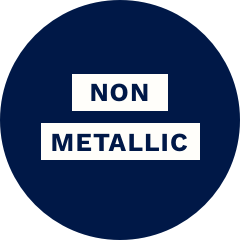
This symbol signifies a non-metallic upper. If a shoe has this symbol, it means that it features eyelets on the upper portion of the shoe that are made of nylon or plastic, or hidden or non-existent. This helps to reduce the chance of marking or scratching work surfaces, and are also utilized on security friendly footwear.

This symbol signifies that the shoe or boot is security friendly. This means that the shoe has a composite toe and eyelets that are 100% non-metallic, and will typically not activate security-screening devices.

This symbol means that the shoe is insulated. A shoe with this symbol means that it contains an insulating lining such as Thinsulate which is designed to keep your feet warm in cold conditions. The higher the gram rating for the shoe, the warmer your feet will stay.

This symbol tells you that the shoes are completely waterproof. This will allow your feet to stay dry in most wet conditions due to membranes such as Gore-Tex.

This symbol indicates that the style of the shoe or boot features a lug sole design. This design improves traction outdoors in different environments such as mud, snow and grass.
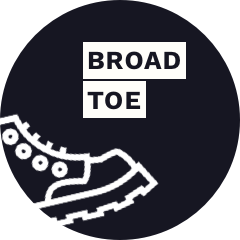
This symbol tells you that the shoe features a protective toe cap that is larger than a standard toe cap. This provides extra room for your toes to bend, move and flex while you walk and stand.
ASTM-Related Icons


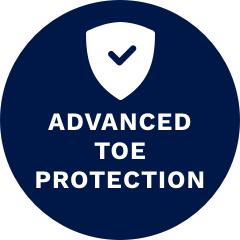
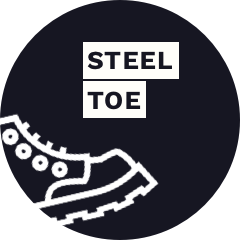

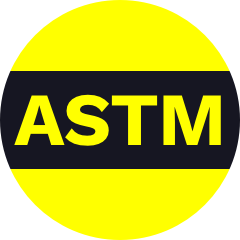

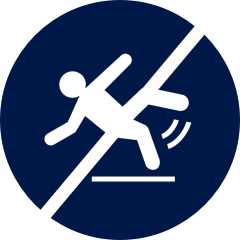


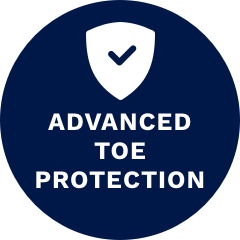


Standards (ASTM)
In order to ensure safety, standards for work boots and shoes have been developed. The ASTM F2413-11 standard covers the minimum requirements for design, performance, testing and classification of protective footwear. It includes the seven footwear protection standards that are described below. In order to comply with the standards, footwear must be tested and certified by a third party independent testing agency, and the standards have to be clearly and legibly labeled inside the footwear. The labels in the shoes look similar to the photo below.

The top line of this photo shows the ASTM standard number (F2413) and the year of issuance (-11). Typically, this information won’t change. If it does, it will only be the year of issuance.
The second line clarifies whether it’s a male or female (M or F) and that it’s certified for impact and compression (I/75 and C/75). This information typically doesn’t change from style to style except for the gender.
The third (and potentially fourth) lines are there to describe additional features that the shoes or boots may have. This information will change from style to style and communicates the features of a shoe or boot.
Protection Standards (ASTM)
- Impact (I/75)
- Identifies protection against impact hazards. The test for this standard involves dropping a 50 pound weight from a height of 18” (75 ft. lbf.) onto 3 test samples. A minimum 0.5-inch clearance (men’s) and 0.468 (women’s) must be maintained on all 3 test samples. These shoes or boots will also meet the compression standards below.
- Compression (C/75)
- Identifies protection against rolling or compression hazards. 2,500 lbs. of force is applied to 3 test samples. Minimum clearance as above must be maintained on all 3 samples. This footwear must also meet the above impact requirements.
- Metatarsal (MT 75)
- Identifies footwear designed to protect the top of the foot from impacts. A 50 lb. weight is dropped from a height of 18” on 3 test samples. A minimum 1-inch clearance (men’s) and .937 inch (women’s) must be maintained on all 3 test samples. Footwear must first meet the above impact and compression tests for the toecap.
- Conductive (CD)
- Identifies footwear intended to provide protection against hazards from static electricity buildup and reduce the possibility of ignition of explosive or volatile chemicals. This footwear is tested to demonstrate resistance between 0 and 500,000 ohms. Please Note: Conductive footwear is not intended to be worn if working near open electrical circuits.
- Electrical Hazard (EH)
- Identifies footwear constructed to provide a secondary level of protection against incidental contact with live electrical circuits. Three specimens are tested to resist the application of 18,000 volts at 60 hertz for 1 minute with no current flow in excess of 1 milliampere under dry conditions. All 3 specimens must pass the minimum test requirements.
- Static Dissipative (SD)
- Identifies footwear designed to protect against hazards that may exist due to excessively low footwear resistance while maintaining a sufficiently high level of resistance to reduce the possibility of electrical shock. This footwear must have a lower limit of electrical resistance of 1 megohm and an upper limit of 100 megohms.
- Puncture Resisting (PR)
- Identifies footwear designed and constructed with a puncture resistance feature between the insole and outsole as a permanent part of the footwear. This footwear must have a minimum puncture resistance of 270 lbs. of force.
All of the above shoe and boot components are an integral and permanent part of the construction and selection of the footwear. Other devices that serve as temporary protection do not conform to ASTM standards. if you have any questions about work or safety shoes and boots please feel free to email us at online@rogansshoes.com or call us toll free at 1-800-976-4267.
Shop:



 Safety Footwear
Safety Footwear 
